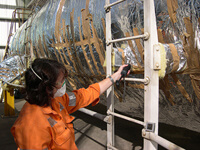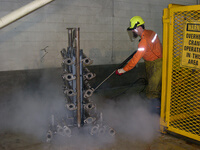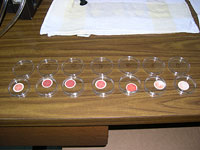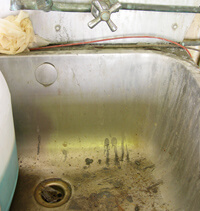Canary North can provide professional assistance with your risk management process, where the specialist skills and knowledge of an occupational hygienist are of value and not available within the workplace.
Very generally the risk management process is concerned with identifying the hazards in the workplace, and then managing the risks associated with those hazards. Many larger workplaces have in-house risk management procedures that they can follow. For smaller workplaces, the QLD WH&S Risk Management Advisory Standard is an excellent source of guidance.
A fundamental step in risk management is an assessment of the degree of risk that a given hazard presents.
This involves:
- An estimation of the likelihood of an incident occurring, bearing in mind any existing control measures
- An estimation of the consequences of the incident
- From the likelihood and consequences, assign a risk rating

Grab sampling of gases using
Gastec detector tubes
The risk rating assists in decisions about the need for additional controls, the urgency of implementing additional controls, and the priority they assume in the overall risk management efforts in the workplace.
Information about the risk management process - hazard identification, evaluation, control
A risk management approach is required for occupational hygiene hazards, with the initial step being to identify any hazards that exist. The identification process may be quite simple where issues are known and obvious, or it may require a more complex investigation and expert advice where they are not. Tools that assist in identifying hazards might include:
- Walk-through surveys
- Worker consultation
- Review of workplace processes and operations
- Review of MSDS, labels or other appropriate literature
- Review of previous assessments when available
- Review of workplace incident/injury records

High pressure steam cleaning of pipe work
Once identified, some evaluation of the hazard is necessary. This is essentially to determine the magnitude of risk that a hazard may present to the workers health and safety. WH&S legislation requires that risk to the worker be prevented, or where this is not possible, minimised in so far as is practicable. When a hazard is known and obvious, resources may best be applied to the elimination or minimisation of this hazard.
However monitoring is often required to evaluate a hazard and this might include:
- Where it is necessary to determine if a potential hazard does in fact exist
- Where it is desirable to determine the degree to which a hazard might exist, so as to best allocate resources
- Where the effectiveness of control measures are being assessed or reviewed
- To demonstrate compliance with health and safety obligations
- Review of previous assessments when available
- Review of workplace incident/injury records

Filters loaded from dust sampling ready for dispatch to lab.
In these cases the appropriate use of occupational sampling is essential to obtaining the required information.
However sampling is only part of the evaluation process, and to be meaningful there must be some standard against which a result can be compared. The standard applied should be considered carefully to ensure it is appropriate to the circumstances and is from an appropriate source. Standards may be prescribed in legislation, they may be values set and recommended by other appropriately recognised bodies, or standards that are adopted internally by an organisation or workplace. While not to be considered as fine lines between what is safe or unsafe, standards are necessary and valuable as guidelines in evaluating the degree of risk that a hazard may pose.

Contamination at pump that maintenance crews must work with.
In the case of chemial hazards, the appropriate standard will often be the relevant National Exposure Standard. The National Exposure Standard is the airborne concentration of a substance in the worker’s breathing zone which, according to current knowledge should not cause adverse health effects or undue discomfort to nearly all workers.
For any given substance this exposure standard can be in one or more of three forms; time-weighted average (TWA), peak limitation (PEAK), or short term exposure limit (STEL). It is important to ensure that the monitoring conducted is appropriate for the exposure standard/s with which compliance is sought.
Once a hazard has been found to present an unacceptable degree of risk, appropriate control measures must be considered. The Hierarchy of Controls provides a list of measures in order of the priority that they should be applied. From most to least desirable these are:

Workplace contamination
of hand washing facilities
- Elimination
- Engineering controls
- Substitution controls
- Ventilation controls
- Administration controls
- PPE
Of course individual cases will require controls that are specifically designed with consideration of all aspects of that situation, though consideration must be given to the Hierarchy of Controls and controls chosen from as high a level as possible.

Complex pipe work at batch processing plant
